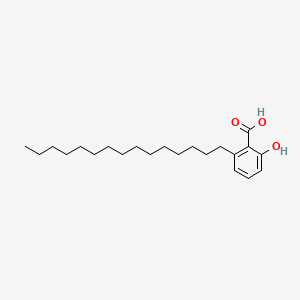| Authors | Title | Published | Journal | PubMed Link |
|---|---|---|---|---|
| Devipriya B and Kumaradhas P | Probing the effect of intermolecular interaction and understanding the electrostatic moments of anacardic acid in the active site of p300 enzyme via DFT and charge density analysis. | 2012 | J. Mol. Graph. Model. | pmid:22306413 |
| Rajendran P et al. | Dietary phytochemicals, HDAC inhibition, and DNA damage/repair defects in cancer cells. | 2011 | Clin Epigenetics | pmid:22247744 |
| Shimura M et al. | Epigenetic displacement of HP1 from heterochromatin by HIV-1 Vpr causes premature sister chromatid separation. | 2011 | J. Cell Biol. | pmid:21875947 |
| Wu Y et al. | Anacardic acid (6-pentadecylsalicylic acid) inhibits tumor angiogenesis by targeting Src/FAK/Rho GTPases signaling pathway. | 2011 | J. Pharmacol. Exp. Ther. | pmid:21828260 |
| Hsieh CC et al. | Lunasin-aspirin combination against NIH/3T3 cells transformation induced by chemical carcinogens. | 2011 | Plant Foods Hum Nutr | pmid:21562729 |
| Pandey D et al. | SUMO1 negatively regulates reactive oxygen species production from NADPH oxidases. | 2011 | Arterioscler. Thromb. Vasc. Biol. | pmid:21527745 |
| Peña AN et al. | MRG15 activates the cdc2 promoter via histone acetylation in human cells. | 2011 | Exp. Cell Res. | pmid:21324423 |
| Colussi C et al. | Nε-lysine acetylation determines dissociation from GAP junctions and lateralization of connexin 43 in normal and dystrophic heart. | 2011 | Proc. Natl. Acad. Sci. U.S.A. | pmid:21282606 |
| Sukumari-Ramesh S et al. | Anacardic acid induces caspase-independent apoptosis and radiosensitizes pituitary adenoma cells. | 2011 | J. Neurosurg. | pmid:21275565 |
| Song C et al. | Paraquat induces epigenetic changes by promoting histone acetylation in cell culture models of dopaminergic degeneration. | 2011 | Neurotoxicology | pmid:21777615 |
| Oliveira MS et al. | Antioxidant, larvicidal and antiacetylcholinesterase activities of cashew nut shell liquid constituents. | 2011 | Acta Trop. | pmid:20707981 |
| Hung CH et al. | Modulation of cytokine expression in human myeloid dendritic cells by environmental endocrine-disrupting chemicals involves epigenetic regulation. | 2010 | Environ. Health Perspect. | pmid:20056579 |
| Schultz DJ et al. | Anacardic acid inhibits estrogen receptor alpha-DNA binding and reduces target gene transcription and breast cancer cell proliferation. | 2010 | Mol. Cancer Ther. | pmid:20197399 |
| Souto JA et al. | New anacardic acid-inspired benzamides: histone lysine acetyltransferase activators. | 2010 | ChemMedChem | pmid:20683922 |
| Ghizzoni M et al. | Improved inhibition of the histone acetyltransferase PCAF by an anacardic acid derivative. | 2010 | Bioorg. Med. Chem. | pmid:20655754 |
| Tedong L et al. | Hydro-ethanolic extract of cashew tree (Anacardium occidentale) nut and its principal compound, anacardic acid, stimulate glucose uptake in C2C12 muscle cells. | 2010 | Mol Nutr Food Res | pmid:20603833 |
| Awe S and Renkawitz-Pohl R | Histone H4 acetylation is essential to proceed from a histone- to a protamine-based chromatin structure in spermatid nuclei of Drosophila melanogaster. | 2010 | Syst Biol Reprod Med | pmid:20170286 |
| Logrado LP et al. | Synthesis and cytotoxicity screening of substituted isobenzofuranones designed from anacardic acids. | 2010 | Eur J Med Chem | pmid:20537433 |
| Song C et al. | Environmental neurotoxic pesticide increases histone acetylation to promote apoptosis in dopaminergic neuronal cells: relevance to epigenetic mechanisms of neurodegeneration. | 2010 | Mol. Pharmacol. | pmid:20097775 |
| Wort SJ et al. | Synergistic induction of endothelin-1 by tumor necrosis factor alpha and interferon gamma is due to enhanced NF-kappaB binding and histone acetylation at specific kappaB sites. | 2009 | J. Biol. Chem. | pmid:19592490 |
ANACARDIC ACID
ANACARDIC ACID is a lipid of Polyketides (PK) class.
